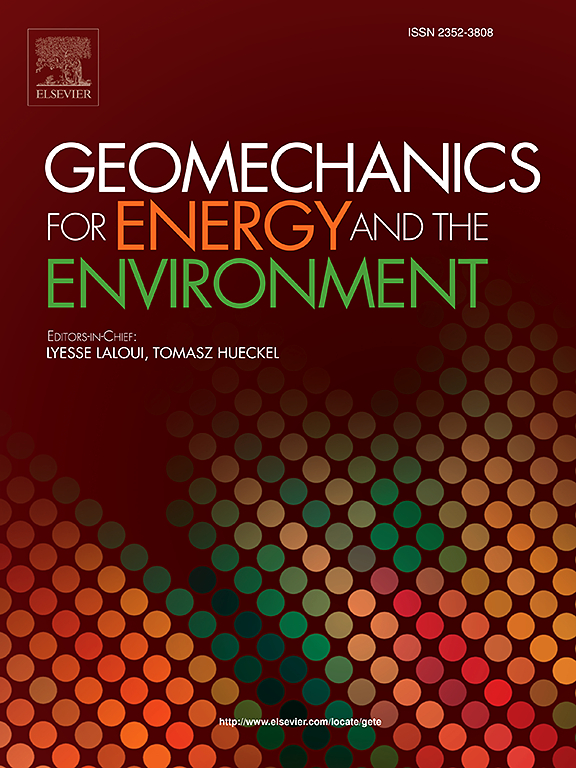Coupled thermo-hydro-mechanical modeling of fracture interactions in enhanced geothermal systems
IF 3.7
2区 工程技术
Q3 ENERGY & FUELS
引用次数: 0
Abstract
This paper presents the use of the mesh fragmentation technique (MFT) for modeling hydraulic stimulation and heat production in enhanced geothermal systems (EGS). This method simulates evolving hydraulic fractures induced by thermo-hydro-mechanical (THM) phenomena and their interaction with pre-existing natural fractures, forming an interconnected network for water circulation and energy production. The MFT combines high aspect ratio (HAR) elements within a standard finite element (FE), using appropriate constitutive models to describe mechanical, hydraulic, and thermal behaviors. Fracture evolution occurs naturally, governed only by local THM conditions and material properties, without needing special tracking algorithms or remeshing techniques. This approach relies on continuum mechanics and standard FE technology, employing simple models for energy dissipation, flow, and thermal transport due to enhanced porosity and permeability. Three application cases validate this technique. First, the proposed model shows excellent agreement with published thermo-hydraulic solutions, validating its implementation. Second, it effectively handles interactions between natural and hydraulic-driven fractures. Third, it models EGS operation for over 60 years under different in-situ stress scenarios and natural fracture densities. The results show the technique's effectiveness in modeling complex EGS scenarios and demonstrate its potential for optimizing EGS design.
增强型地热系统中裂缝相互作用的热-水-力学耦合模拟
本文介绍了利用网格破碎技术(MFT)对增强型地热系统(EGS)的水力增产和产热进行建模。该方法模拟了由热-水-机械(THM)现象引起的水力裂缝的演化,以及它们与已有天然裂缝的相互作用,形成了一个相互关联的水循环和能源生产网络。MFT在标准有限元(FE)中结合了高纵横比(HAR)元素,使用适当的本构模型来描述机械、水力和热行为。断裂的演变是自然发生的,只受局部THM条件和材料特性的控制,不需要特殊的跟踪算法或重网格技术。该方法依赖于连续介质力学和标准有限元技术,采用简单的模型来计算由于孔隙度和渗透率增加而导致的能量耗散、流动和热输运。三个应用案例验证了该技术。首先,所提出的模型与已发表的热液解决方案非常吻合,验证了其可行性。其次,它有效地处理了天然裂缝和水力裂缝之间的相互作用。第三,模拟了60多年来不同地应力和天然裂缝密度下的EGS作业。结果表明,该技术在复杂的EGS场景建模中是有效的,并展示了其优化EGS设计的潜力。
本文章由计算机程序翻译,如有差异,请以英文原文为准。
求助全文
约1分钟内获得全文
求助全文
来源期刊

Geomechanics for Energy and the Environment
Earth and Planetary Sciences-Geotechnical Engineering and Engineering Geology
CiteScore
5.90
自引率
11.80%
发文量
87
期刊介绍:
The aim of the Journal is to publish research results of the highest quality and of lasting importance on the subject of geomechanics, with the focus on applications to geological energy production and storage, and the interaction of soils and rocks with the natural and engineered environment. Special attention is given to concepts and developments of new energy geotechnologies that comprise intrinsic mechanisms protecting the environment against a potential engineering induced damage, hence warranting sustainable usage of energy resources.
The scope of the journal is broad, including fundamental concepts in geomechanics and mechanics of porous media, the experiments and analysis of novel phenomena and applications. Of special interest are issues resulting from coupling of particular physics, chemistry and biology of external forcings, as well as of pore fluid/gas and minerals to the solid mechanics of the medium skeleton and pore fluid mechanics. The multi-scale and inter-scale interactions between the phenomena and the behavior representations are also of particular interest. Contributions to general theoretical approach to these issues, but of potential reference to geomechanics in its context of energy and the environment are also most welcome.
 求助内容:
求助内容: 应助结果提醒方式:
应助结果提醒方式:


